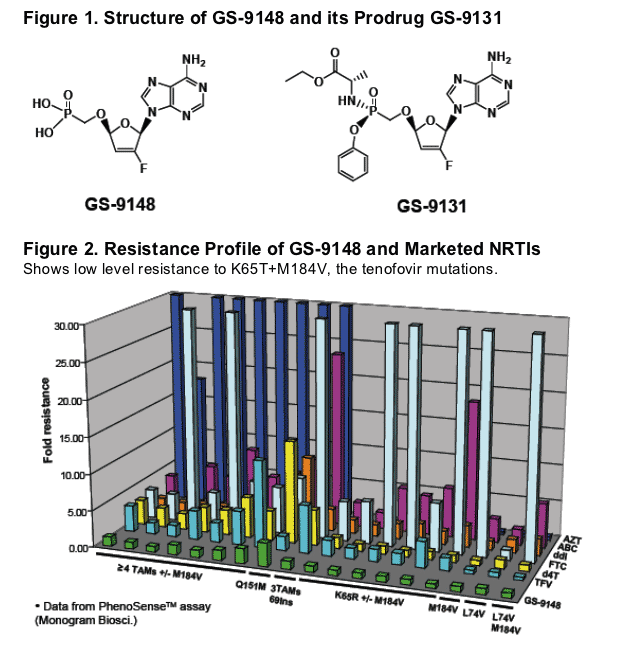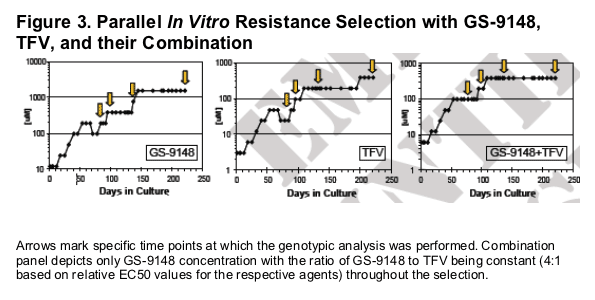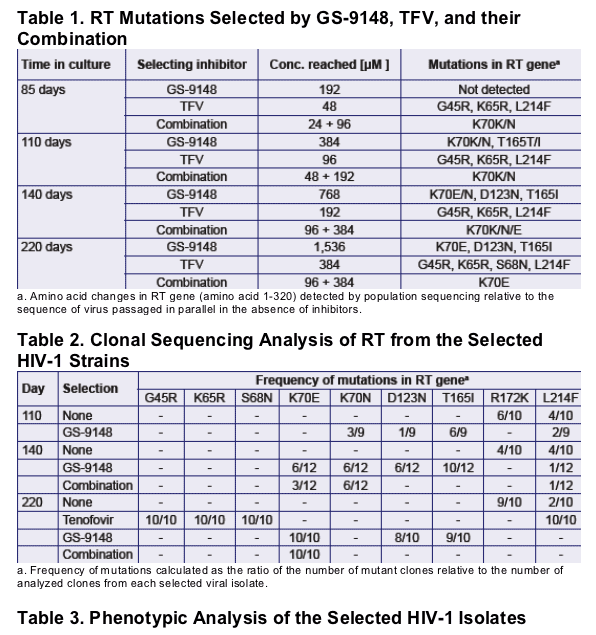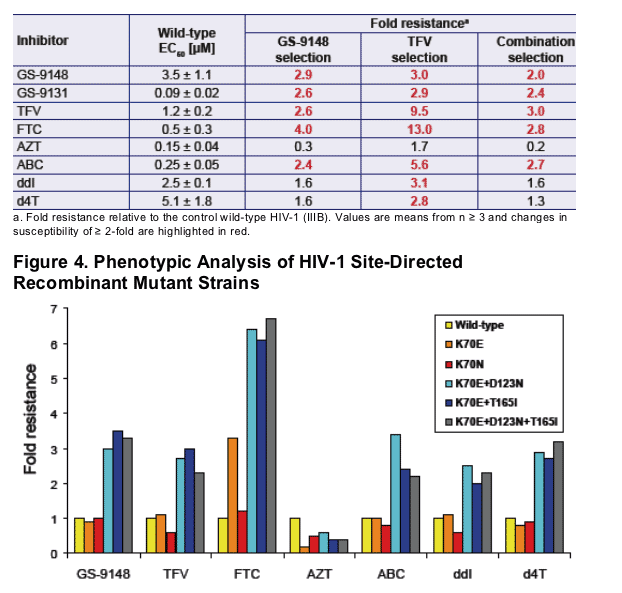 |
 |
 |
| |
Novel Nucleotide Inhibitor GS-9148 Selects for a K70E Mutation in HIV-1 Reverse Transcriptase and Low-Level Resistance In Vitro
|
| |
| |
Reported by Jules Levin
ICAAC sept 17-20, 2007, Chicago
G Laflamme, D Grant, K White, K Stray, C Boojamra, L Zhang, R Mackman, A Ray, M Miller, and T Cihlar
Gilead Sciences, Inc., Foster City, CA
INTRODUCTION
GS-9148 (Fig. 1) is a novel nucleotide HIV RT inhibitor with a favorable in vitro
resistance profile against HIV-1 strains with clinically relevant mutations including
M184V, K65R, L74V, and ≥ 4 TAMs (Fig. 2)1.
GS-9131 (Fig. 1), an orally bioavailable phosphonoamidate prodrug of GS-9148
capable of effectively delivering GS-9148 diphosphate into PBMCs in vivo2 is
an attractive candidate for clinical development for the treatment of HIV-infected
patients with NRTI resistance.
Here we report on the evolution and characterization of HIV-1 variants selected in vitro in the presence of nucleotide inhibitors GS-9148, tenofovir (TFV), and their combination.
AUTHOR CONCLUSIONS
GS-9148 selected for K70E+D123N+T165I in RT and 3-fold resistance to both GS-9148 and GS-9131. The selected virus showed low level cross-resistance to TFV, FTC and ABC and was hypersensitive to AZT. Only combinations of K70E with D123N and/or T165I, but not individual selected mutations, confer detectable reduced susceptibility to GS-9148
Virus selected in parallel by TFV contained the expected K65R mutation and exhibited a higher degree of NRTI cross-resistance than the virus selected by GS-9148
The combination of GS-9148+TFV selected for a single K70E mutation, indicating the ability of GS-9148 to shift the TFV resistance pathway away from K65R. This is consistent with the lack of GS-9148 resistance due to K65R1
Analysis of the Stanford HIV Resistance Database showed a low frequency of K70E in NRTI-experienced patients (0.3%); combinations of K70E with either D123N or T165I have not been found in the database samples
In summary, prolonged in vitro exposure to GS-9148 leads to the selection of a rare combination of RT mutations and low-level resistance

METHODS
Parallel selections with GS-9148, TFV, and their combination were conducted in MT-2 cells infected with HIV-1(IIIB). Virus cultures were passaged at least once a week for 32 weeks in the presence of gradually increasing concentrations of selecting inhibitors.
Both the population and clonal sequencing of PCR-amplified fragments of RT gene (aa1-320) from the selected HIV-1 isolates was performed by Elim Biopharmaceuticals (Hayward, CA).
Recombinant HIV-1 strains containing mutations selected by GS-9148 were constructed by a site-directed mutagenesis of an infectious chimeric LAI (backbone)/IIIB(RT) cDNA clone of HIV-1.
Susceptibilities of selected isolates and recombinant strains to GS-9148 and marketed NRTIs were determined in MT-2 cells using an XTT-based cytopathic
assay3.
The frequency of GS-9148 selected RT mutations among patients HIV-1 isolates was evaluated via an on-line search of the Stanford HIV Drug Resistance Database4.
RESULTS



Values are means from n = 3. No resistance to any of the tested NRTIs was observed with recombinant strains containing D123N, T165I, or their combination in the absence of K70E (data not shown).
References
1. Cihlar T. et al. Abstr. 45, 13th CROI, 2007.
2. Ray A. et al. Abstr. 498, 13th CROI, 2007.
3. Weislow O.S. et al. J Natl Cancer Inst 81: 577-86, 1989.
4. Stanford HIV Drug Resistance Database (http://hivdb.stanford.edu/), 2006.
|
| |
|
 |
 |
|
|